Select Language
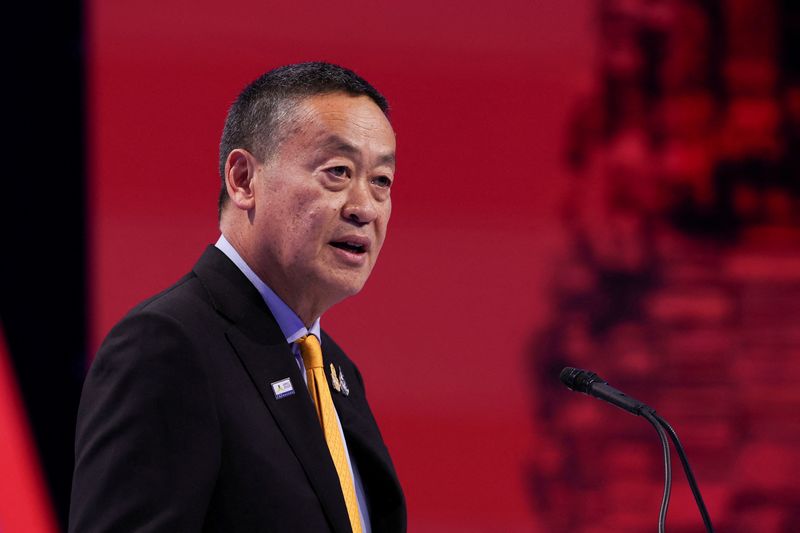
BANGKOK (Reuters) - Thai Prime Minister Srettha Thavisin said on Thursday the country's economy was in "crisis", stressing the need to forge ahead with his controversial 500 billion baht ($14.23 billion) digital handouts policy.
Speaking at a forum, Srettha said the economy was not in good shape with fewer foreign arrivals than targeted, and he would be prioritising attracting foreign investment and addressing household debt.
"There needs to be big economic stimulus," said Srettha, who is also finance minister, adding a plan to tackle debt would be announced on Dec. 12.
His comments comes days after data from the state-planning agency showed lower-than expected growth of 1.5% in the July-September quarter from a year earlier, the slowest pace this year, on weak exports and government spending.
Thailand recorded 23.85 million foreign tourists arriving from Jan 1 to Nov. 19, spending 1 trillion baht.
It is targeting 28 million arrivals versus a pre-pandemic record of nearly 40 million foreign tourist arrivals in 2019 who spent 1.91 trillion baht.
Srettha's "digital wallet" policy, which entails handouts of 10,000 baht to 50 million Thais next year to spend in their localities, has come under criticism in recent months by economists and former central bankers over risks of it breaching financial discipline.
In recent weeks, government officials have described the economy to be in a crisis, necessitating its signature plan.
Srettha, a real estate tycoon and newcomer to politics, is targeting average growth of 5% annually over the next four years in Southeast Asia's second-largest economy, which grew an average 1.9% over the past decade, lagging regional peers.
Speaking at the same forum, Bank of Thailand Governor Sethaput Suthiwartnarueput said the country's fiscal and monetary policies required space to ensure the economy remains resilient as it grows.
"Elements of resiliency include stability, strong balance sheets, fiscal and monetary policy with various options," he said.
In September, the Bank of Thailand (BOT) unexpectedly raised the key interest rate by a quarter point to 2.50%, the highest in a decade, saying growth and inflation should pick up next year. It will next review policy on Nov. 29.
($1 = 35.1300 baht)
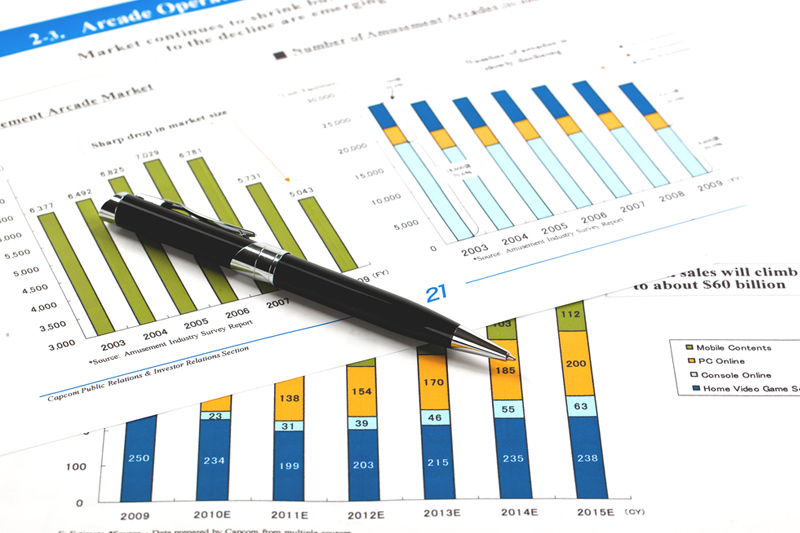
In early Asian trading today, gold prices experienced a downturn, moving from $2,006 to $1,990, amid a stronger US dollar and rising Treasury yields. The US Dollar Index, a measure of the currency's strength against a basket of other major currencies, reached 103.88. Concurrently, Treasury yields saw an increase of 4.40%. This movement in the markets comes as the University of Michigan Consumer Sentiment Index reported a rise to 61.3, setting the tone for market sentiment before the Thanksgiving Day holiday.
The precious metal's decline also follows recent insights from the Federal Open Market Committee (FOMC) Meeting Minutes released on Tuesday. The minutes revealed a collective preference among policymakers for a careful approach to monetary policy that takes into account current economic conditions and associated risks.
Investors in gold are now looking ahead to the release of S&P Global Purchasing Managers' Index (PMI) data, which is expected to influence market trends. The Manufacturing PMI is projected at 49.8, while Services PMI is anticipated at 50.3.
Additional economic indicators that may be swaying investor sentiment include a sharp drop in jobless claims to 209,000 and a decrease in continuing claims to 1.84 million. Meanwhile, Durable Goods Orders showed a contraction of 5.4% month-over-month in October, and inflation expectations for the next year edged up slightly to 4.5%, according to the University of Michigan data. These mixed signals reflect an economy grappling with inflationary pressures while showing signs of resilience in the labor market.
This article was generated with the support of AI and reviewed by an editor. For more information see our T&C.
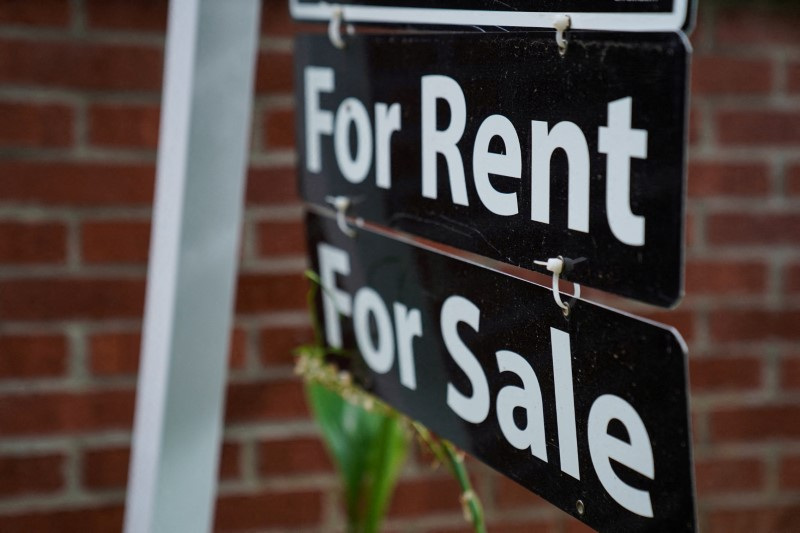
(Reuters) -The average interest rate on the most popular U.S. home loan fell last week to its lowest level in two months as Treasury market yields, which act as a benchmark for mortgage rates, continued to move lower on the back of cooling inflation and a softening economy.
The average contract rate on a 30-year fixed-rate mortgage declined by 20 basis points to 7.41% for the week ended Nov. 17, data from the Mortgage Bankers Association (MBA) showed on Wednesday. It has declined 45 basis points over the past two weeks and is now at its lowest level since late September.
The yield on the 10-year Treasury note acts as a benchmark to set home loan costs. Home-purchasing borrowing costs had reached two-decade highs near 8% in October.
A more timely mortgage tracker also saw the average rate on a 30-year fixed-rate mortgage fall to a two-month low. It fell to 7.29% this week from 7.44% the week before, according to a Freddie Mac survey released later on Wednesday.
The third consecutive weekly decline in both gauges comes amid signals that the Federal Reserve is unlikely to raise interest rates further. At the beginning of the month it kept its key overnight policy rate unchanged for a second straight meeting and policymakers have since indicated they would raise interest rates again only if progress in controlling inflation faltered.
The dip in mortgage rates meant more would-be purchasers. The MBA's Market Composite Index, a gauge of mortgage applications for both home purchases and refinancings of existing loans, rose 3.0% from a week earlier to a six-week high.
The MBA's Purchase Composite Index, a measure of all mortgage loan applications for purchase of a single family home, increased 3.9% from the prior week.
Purchase applications, however, remain well below typical levels, indicating would-be buyers are still waiting on the sidelines despite the decline in rates.
Sellers locked into lower mortgage rates also continue to hold their homes, keeping housing inventory tight.
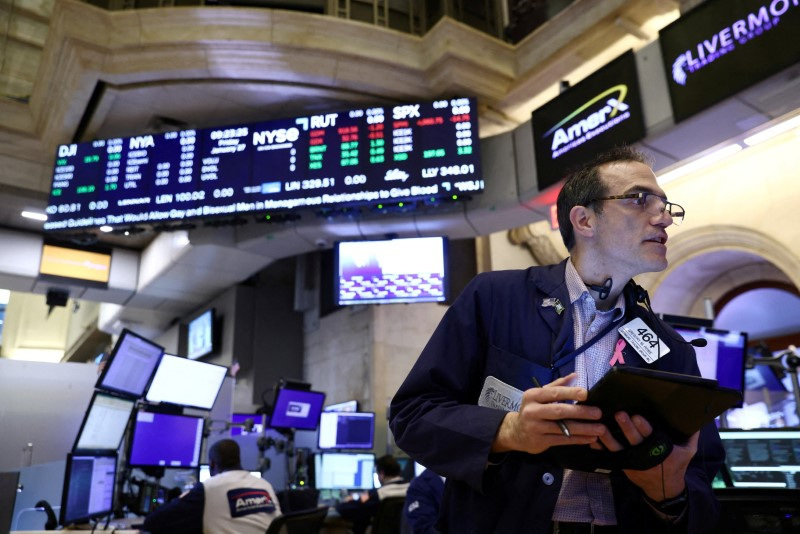
By Hari Kishan and Indradip Ghosh
BENGALURU (Reuters) - Most key global stock indexes are forecast to rise modestly over the coming year, closing 2024 below record highs, while a slim majority of stock market experts polled by Reuters expected their markets to touch new peaks within the next six months.
Much will depend on interest rate expectations now central banks are mostly done with a season of aggressive rate rises since the COVID pandemic to dampen a burst of inflation still not completely under control.
Traders and analysts mostly assume the U.S. Federal Reserve will be cutting interest rates by the middle of next year, an outcome that is far from certain and does not clearly align with policy statements from top central bankers.
Those rate cut expectations are partly behind the views of a slim majority of survey respondents, 46 of 82, who said most key indexes would reclaim record highs by then.
However, only a handful of the 15 top stock indexes were predicted to trade at record peaks by end-2024, based on a wider Nov. 9-22 poll of more than 120 stock market experts.
"After two straight quarters recommending cash over stocks and bonds, we now expect equities to eke out high single-digit returns in 2024 and outperform core fixed income," noted Ajay Rajadhyaksha, global chairman of research at Barclays.
"Yes, we expect the economy to grow more slowly next year, in both real and nominal terms...But the downside risks to the world economy have diminished greatly. We think stocks will benefit from a fairly benign bottom to this business cycle."
A strong majority of respondents, 72 of 85, expected corporate earnings in their local market to increase over the coming six months. The remaining 13 said they would decrease.
Despite high interest rates, cooling global inflation, and with it, economic activity, only a slim majority of respondents, 44 of 80, said value stocks would outperform growth stocks over the next six months.
LOWER BOND YIELDS
For now, markets are pricing in a series of 2024 rate cuts, which is sending bond yields lower and stock prices higher.
U.S. 10-year Treasury note yields breached 5.00% last month for the first time since July 2007 but are not expected to revisit that level according to a separate Reuters poll of bond strategists who were proven wrong on the same call for three straight months.
Lower bond yields will likely be required to further any expected gains in stocks, as they had reached a point where investors had got used to years of paltry yields but now represent good value along with security.
But it is not at all guaranteed that trend will continue, having fallen around 60 basis points on U.S. 10-year yields in the last few weeks alone.
"Falling bond yields are being interpreted by equity markets as a positive in the near-term," said Marko Kolanovic, chief global markets strategist at J.P. Morgan.
"However, we believe that equities will soon revert back to an unattractive risk-reward as the Fed is set to remain higher for longer, valuations are rich, earnings expectations remain too optimistic, pricing power is waning, profit margins are at risk and the slowdown in topline growth is set to continue."
The benchmark S&P 500 index was forecast to finish next year at 4,700, only about 3% higher from its Monday close, with a possible U.S. economic slowdown or recession among the biggest risks for the market in 2024.
European equity markets were also expected to eke out modest gains in 2024 as optimism global interest rates have peaked is offset by worries the economy could fall into a recession.
The pan-European benchmark STOXX 600 index was forecast to rise 4.1% to 475 points by the end of next year, from Monday's close at 456.26.
Canada's main stock index was expected to rise less than previously thought over the coming year as a slowdown in the global economy weighs on the outlook for corporate earnings.
Among the indices surveyed Japan's Nikkei 225 and India's BSE index were expected to continue their strong performance into the next year with the Nikkei expected to reach a three-decade high of 35,000 by end-June of next year and the BSE forecast to hit new highs in 2024.
(Other stories from the Reuters Q4 global stock markets poll package:)
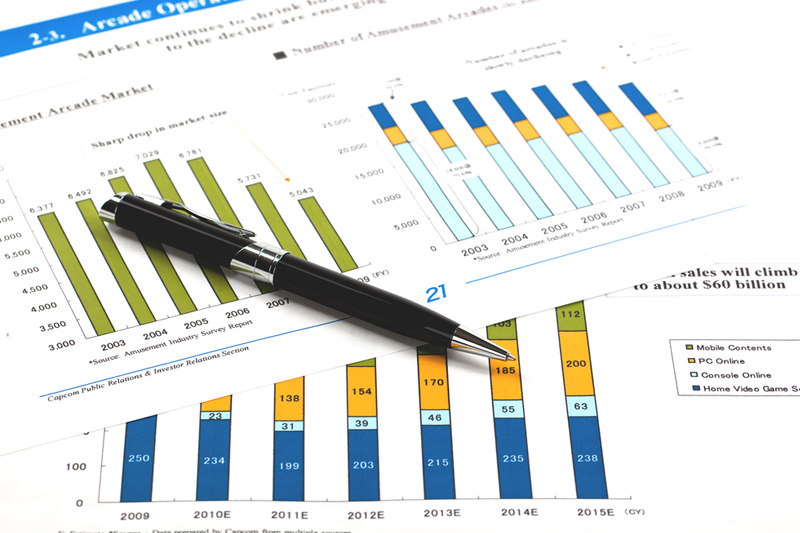
Analysts are projecting a robust growth trajectory for India's economy, with the Gross Domestic Product (GDP) expected to expand to 6.5% in the fiscal year 2024-25. This uptick is attributed to increased government spending ahead of elections and a surge in post-election private investments.
According to a recent analysis by Goldman Sachs, the Indian economy is set to experience a slight deceleration from an estimated growth rate of 6.4% in 2023 to 6.3% in 2024. However, the firm anticipates that the growth will regain momentum, reaching 6.5% in FY25. This growth is anticipated despite ongoing supply shocks and macroeconomic resilience that are likely to keep headline inflation above the target at around 5.1%.
In addition to GDP growth, Goldman Sachs forecasts a narrowing of India's fiscal deficit. The deficit is expected to decrease from nearly six percent of GDP in FY24 to about five percent in FY25. This improvement will be a key factor in the country's economic stability.
The current account deficit, however, is projected to rise to nearly two percent of GDP, driven by higher oil prices and persistent supply shocks that contribute to inflationary pressures. Despite these challenges, Goldman Sachs predicts that headline inflation will remain just above five percent year-over-year, with core inflation anticipated to drop slightly below this level compared to last year’s figures.
This article was generated with the support of AI and reviewed by an editor. For more information see our T&C.
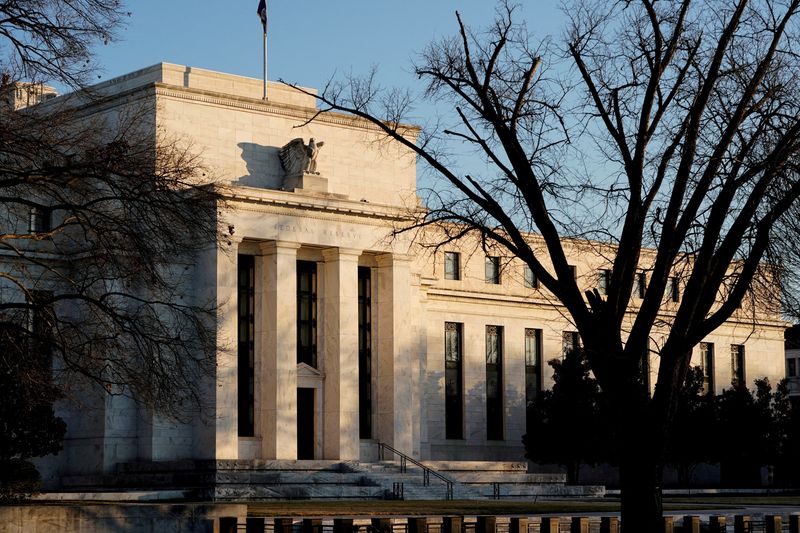
By Mike Dolan
LONDON (Reuters) - If you were looking for a klaxon to mark the end of the interest rate cycle, a crushing of currency market volatility rings loudly.
Deutsche Bank's CVIX - the currency market's version of Wall St's "fear index" of stock volatility and a weighted average of implied "vol" in nine major pairings - has basically imploded.
Subdued since mid-year, the CVIX took another sharp leg lower this month and hit its lowest since mid-February 2022 - just before Russia's invasion of Ukraine and the first of the U.S. Federal Reserve's severe five-percentage-point-plus rate rise campaign that March.
The index - where the dominant weightings of 3-month implied vol in euro/dollar and dollar/yen exchange rates account for more than 50% - is now exactly half the peaks of September last year and some 1.5 points below its historic average.
On the face of it the subsidence of volatility marks the end of "King Dollar's" latest turbulent rule as Fed tightening ceases and easing speculation now lies ahead.
By driving short-term dollar cash rates and U.S. bond yields higher over the past 20 months, the Fed basically sucked cash from the wider investment world and supercharged dollar exchange rates everywhere. Now that it looks done, the buck's finally on the back foot - plumbing levels not seen since August.
In what ING strategists Chris Turner and Francesco Pesole describe as the dollar's "long goodbye" - 2024 looks set to for a persistent, trending bear market for the greenback that in itself will sap volatility as risk markets reflate on the back of central bank easing hopes.
"To speak of 'reflationary' policy right now seems criminal – but the Fed has a dual mandate, and if inflation is coming under control through 2024 it can cut rates to ameliorate the impact on the labour force," the ING team wrote, adding commodity currencies within the G10 were a favourite for 2024.
With implied volatility directionally biased, the dollar index and the CVIX are typically well correlated and both peaked in tandem in same month of September last year.
That bias is mainly due to the disruptive aspect of dollar strength - which adds to economic, trade and financial stress around the world via inflation of commodity import prices as well as pressuring dollar-denominated debts in many emerging nations.
That sensitivity, in turn, creates friction and often leading to extreme more extreme monetary policies or even open market intervention to push back - and making a sharp dollar ascent more noisy along the way.
The flipside is more serene for the same reasons in reverse.
'NORTHWEST PASSAGE'
Nowhere is that clearer than in Japan, where Fed tightening met a persistent easy money and yield capping policy at the Bank of Japan, sank the yen to 33-year lows and drew at least one bout of intervention as the government and BOJ attempted to draw line under the yen as the dollar powered through 150 yen.
But with peak Fed rates meeting trough BOJ ones - and both at least leaning in opposite directions next year, then dollar/yen is finally recoiling in earnest and the two-point premium on dollar/yen over euro/dollar implied vol is dissipating too.
For the euro and sterling, the damage of the dollar rise was ameliorated by the parallel tightening at the European Central Bank and Bank of England. And a Fed pivot is most likely to be matched or even pre-empted by them on the downside.
While three-month U.S.-Japan interest rate differentials are their widest since 2000 and still at those peaks, U.S.-German and U.S.-British equivalent rate gaps never topped 2018 highs and are both falling again.
And while a Fed rate cut is now priced into futures by June, so too is a BOE cut - and an ECB ease is baked into money markets as soon as April.
Not much wiggle room for relative currency trades then and volatility is further contained.
And of course these moves have a habit of feeding off each other, not least in how a drop in implied vol feeds carry trades to higher interest rate currencies - not only within the G10 space, but to emerging markets and beyond and reversing the Fed vacuum cleaner of the past two years.
As the ING team point out, the yen would typically suffer in that regime too as it typically acts as cheapest funding currency. But a likely BoJ policy shift cuts across that.
To be sure, the waiting game could see some stasis re-emerge. UBS Global Wealth Management's Solita Marcelli thinks this week's slide may be "overdone" while Fed thinking becomes clearer - though selling dollar rallies probably makes sense in the interim.
But the abrasive resurgence of U.S. Treasury yields through October - as a "term premium" on Treasuries resurfaced due to worries about fiscal policy stasis and rising debt levels - may well have kept the dollar higher than volatility levels would otherwise have suggested over the past two months.
And so with yields on the wane again and the term premium now slipping back into negative territory after just two months, there may be a case for dollar weakness to play catch up.
The alternative take is that the dollar's not done yet and may not give the ghost until the Spring.
Morgan Stanley thinks the DXY index could rebound up to 8% from here to some 111 before finally falling back later in 2024. The argument is that near-term direction remains foggy as rate differentials likely continue to favour the buck through the first half of the year while growth and geopolitical risks support keeping a defensive stance in dollar cash.
"Much like the Northwest Passage in winter, the pathway toward a weaker dollar this winter is narrow, cloudy, and fraught with risk," Matthew Hornbach and team told clients this weekend.
And yet if vol is anything to go by, the clear water is already in sight.
The opinions expressed here are those of the author, a columnist for Reuters

By Kevin Yao
BEIJING (Reuters) - Chinese government advisers will recommend economic growth targets for next year ranging from 4.5% to 5.5% to an annual policymakers' meeting, as Beijing seeks to create jobs and keep long-term development goals on track.
Five of the seven advisers who spoke with Reuters said they favoured a target of around 5%, matching this year's goal. One adviser will propose a 4.5% target, while the other suggested a 5.0-5.5% range.
The proposals will be made next month at the ruling Communist Party's annual Central Economic Work Conference that discusses policy plans and the outlook for the world's second-largest economy.
Reaching such targets would require Beijing to step up fiscal stimulus, the advisers said, given that this year's growth has been flattered by last year's low-base effect of COVID-19 lockdowns.
"We need to adopt expansionary fiscal and monetary policy to stimulate aggregate demand," Yu Yongding, a government economist who advocates for a growth target of roughly 5%, told Reuters.
"Corporate investment demand will not be strong as the confidence of companies has not recovered, so we need to expand infrastructure investment," added Yu, who also favours a budget deficit topping 4% of economic output.
The other advisers spoke on condition of anonymity due to the closed-door nature of the discussions. Top leaders are expected to endorse the target at the December meeting, although it will not be announced publicly until China's annual parliament meeting, usually held in March.
In October, China unveiled a plan to issue 1 trillion yuan ($139 billion) in sovereign bonds by the end of the year, raising the 2023 budget deficit target to 3.8% of gross domestic product (GDP) from the original 3%.
Chinese leaders have pledged to "optimize the structure of central and local government debt", suggesting the central government has room to spend more as its debt as a share of GDP is just 21%, far lower than 76% for local governments.
"We are stepping up fiscal policy support," said another adviser, to make the "difficult" 2024 target "achievable."
Monetary stimulus is expected to play a more limited role as the central bank remains concerned a widening interest rate differential with the West may further weaken the yuan and encourage capital outflows.
"The space for monetary policy could be bigger if we have greater tolerance for exchange rate fluctuations," said Guan Tao, global chief economist at BOC International and a former official at the State Administration of Foreign Exchange (SAFE).
REFORMS VS STIMULUS
China’s economy grew only 3% in 2022, one of its worst performances in nearly half a century. A Reuters poll in October showed that economists expect it to grow 5.0% in 2023 and 4.5% in 2024, although some have since raised their forecasts.
In 2022, President Xi Jinping laid out a long-term vision of "Chinese-style modernisation" at a key party meeting, with a goal of doubling China's economy by 2035 that government economists say would require average annual growth of 4.7%.
The stuttering post-COVID recovery has prompted many analysts to call for structural reforms that tilt the drivers of economic growth away from property and infrastructure investment and towards household consumption and market-allocation of resources.
Absent that, these economists warn, China may begin flirting with Japan-style stagnation later this decade.
Beijing has been trying to reduce economic reliance on property, channelling more resources into high-tech manufacturing and green industries, but has struggled to boost consumer and investor sentiment.
Policy insiders believe more fundamental changes, especially a revival of market-oriented reforms, are unlikely due to the political environment, under which the state has increased its control over the economy, including the private sector.
"If there is no consensus on reforms, we will have to use stimulus to drive growth, even though it will not be sustainable,” a third adviser said.
($1 = 7.2111 Chinese yuan renminbi)
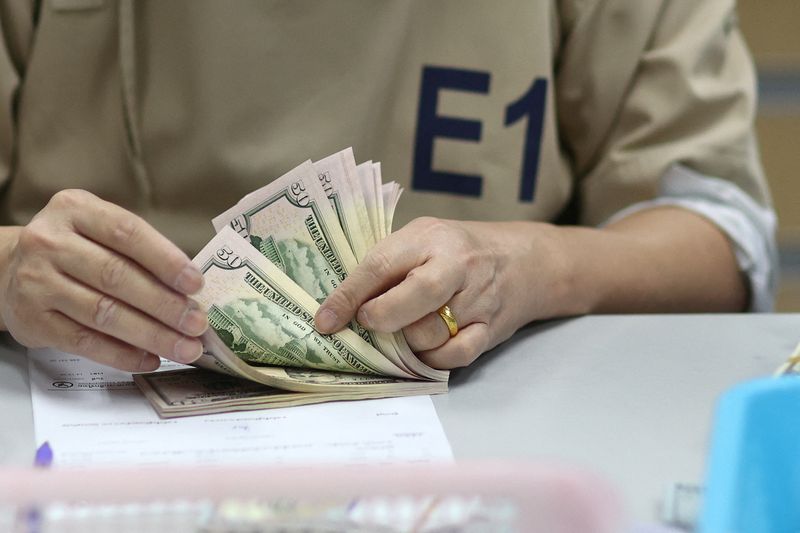
By Brigid Riley
TOKYO (Reuters) - The dollar index held around 2-1/2-month lows after minutes of the Federal Reserve's last meeting did little to dislodge market expectations that its monetary tightening cycle was over.
The Fed minutes showed the central bank would proceed "carefully" and that "all participants judged it appropriate to maintain" the current rate setting.
Fed officials agreed they would only raise interest rates if progress in controlling inflation faltered, reiterating recent comments by policymakers that left the door open for more tightening even as markets have moved to price in cuts from early next year.
"The release of the FOMC November minute did little to sway the opinion that the Fed have reached their terminal rate," said Matt Simpson, senior market analyst at City Index.
Markets are all but certain that the Fed will hold rates at their December meeting, while pricing in about a 30% chance of a rate cut as early as March, according to CME's FedWatch Tool.
The dollar index, which measure the greenback against a basket of currencies, was flat at 103.58, near levels last seen in early September but off an overnight session low of 103.17.
The euro last sat at $1.0912 after rising to its highest against the dollar since mid-August to $1.0966 on Tuesday.
Sterling was mostly flat at $1.2534, not far from a two-month high of $1.2554 touched overnight.
"We’re seeing signs that the dollar bearish move is running out of steam" and could be "due to bounce," Simpson said, adding that the greenback has a tendency to weaken and then strengthen around the time of the U.S. Thanksgiving holiday, which happens on Thursday.
U.S. Treasury yields, which have buoyed the dollar, have also tumbled from multi-year highs hit in October as investors ramp up bets that the Fed is done hiking rates following a slowdown in U.S inflation in the same month. Treasury yields slipped again overnight to hover around 4.40%, easing further pressure on the yen.
The Japanese yen advanced around 0.1% versus the greenback to 148.28, clinging to recent gains after ticking up slightly from as low as 147.155 overnight.
While speculation that the Bank of Japan could exit from negative interest rates early next year should help stabilise the yen, the Japanese currency still faces strong headwinds.
Recent U.S. data have pointed to the resilience of the world's biggest economy, bolstering the Fed's soft landing narrative.
U.S. "growth after the current rebalancing is still expected to outperform, which will support U.S. earnings and yields," said Tony Sycamore, market analyst at IG.
The dollar still holds "a significant yield advantage over the (yen)," he added.

TOKYO (Reuters) - Japan's government on Wednesday slashed its view on the economy for November in its first such downgrade in 10 months, as weak demand weighed on capital spending and consumer expenditure.
Authorities also cut their view on capital expenditure for the first time since December 2021, saying the pace of recovery was "pausing".
The new assessment by the Cabinet Office came after data last week showed the economy shrank in July-September for the first time in three quarters as demand waned.
"The economy is recovering moderately, although some areas showed stalemate recently," said the report issued by the Cabinet Office on Wednesday. It was the first time the government has cut its view on the overall economy since January.
"While business conditions and firms' earnings continue to improve, the strength of the corporate sector is not necessarily translating into wages and investment," an official at the Cabinet Office said.
"Domestic demand such as corporate investment and consumer spending lack strength," he said.
Although the government retained its assessment that consumer expenditure was "picking up" in November, inflation squeezed consumer goods spending, while spending on services such as eating out maintained an uptrend.
In a bid to soften inflation's hit to the economy, Prime Minister Fumio Kishida's government compiled this month a package of measures that will involve spending of more than 17 trillion yen ($113 billion).
The government expects the economy to continue to recover moderately but there are risks such as those from global monetary tightening and the Chinese economy.
Close attention needs to be paid to rising prices, the Middle East situation as well as financial market fluctuations, the report said.
($1 = 149.6200 yen)

A look at the day ahead in European and global markets from Ankur Banerjee
Buoyed by a tech-fuelled rally on Wall Street, risk assets in Asia charged higher on rising expectations the Federal Reserve is done hiking rates and will likely cut early next year.
The worry remains that upcoming data might show not just a slowing U.S. economy but also an economy on the verge of a recession. But for now investors are looking the other way.
MSCI's broadest index of Asia-Pacific shares outside Japan touched a fresh two-month peak and is on track for its best monthly performance since January.
Lower Treasury yields have led the dollar broadly lower against most currencies, with a strong fix on China's yuan piling more pressure on the greenback. The dollar index, which measures the U.S. currency against six of its peers, fell to its lowest since Aug. 31.
Japan's Nikkei remained close to the 33-year high it touched on Monday. A Reuters poll showed analysts expect the index to continue its more-than-28% rally this year into 2024 to reach a three-decade high of 35,000 by end-June.
With the economic calendar bare in Europe, the rally may fizzle out although futures indicate European stock markets are set for a slightly higher open. Investors will turn their focus to minutes of the Federal Reserve's last meeting later in the day for cues on where rates are headed.
The spotlight will shine bright on earnings from artificial intelligence chip leader Nvidia (NASDAQ:NVDA), with expectation of another blockbuster revenue forecast.
Investors have cheered a better-than-expected U.S. earnings season and the results will be a major test for the AI-powered rally that has helped drive up the U.S. stock market this year.
Speaking of AI, the drama surrounding the future of OpenAI shows no sign of stopping. OpenAI named ex-Twitch boss Emmett Shear as interim CEO, while outgoing chief Sam Altman moved to backer Microsoft (NASDAQ:MSFT), in a surprise turn of events that clouded the future of the startup at the heart of the artificial intelligence boom.
Meanwhile, the chief of Hamas told Reuters on Tuesday that the Palestinian militant group was near a truce agreement with Israel, even as the deadly assault on Gaza continued and rockets were being fired into Israel.
Key developments that could influence markets on Tuesday:
Fed minutes, Oct inflation data for Canada, Nvidia earnings

